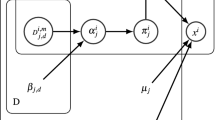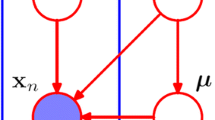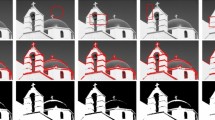Abstract
Spatially varying mixture models are characterized by the dependence of their mixing proportions on location (contextual mixing proportions) and they have been widely used in image segmentation. In this work, Gauss-Markov random field (MRF) priors are employed along with spatially varying mixture models to ensure the preservation of region boundaries in image segmentation. To preserve region boundaries, two distinct models for a line process involved in the MRF prior are proposed. The first model considers edge preservation by imposing a Bernoulli prior on the normally distributed local differences of the contextual mixing proportions. It is a discrete line process model whose parameters are computed by variational inference. The second model imposes Gamma prior on the Student’s-t distributed local differences of the contextual mixing proportions. It is a continuous line process whose parameters are also automatically estimated by the Expectation-Maximization (EM) algorithm. The proposed models are numerically evaluated and two important issues in image segmentation by mixture models are also investigated and discussed: the constraints to be imposed on the contextual mixing proportions to be probability vectors and the MRF optimization strategy in the frameworks of the standard and variational EM algorithm.
Similar content being viewed by others
References
Xu, R., Wunsch II, D.: Survey of clustering algorithms. IEEE Trans. Neural Netw. 16(3), 645–678 (2005)
Bishop, C.M.: Pattern Recognition and Machine Learning. Springer, Berlin (2006)
Dempster, P., Laird, N.M., Rubin, D.B.: Maximum likelihood from incomplete data via the EM algorithm. J. R. Stat. Soc. 39(1), 1–38 (1977)
Carson, C., Belongie, S., Greenspan, H., Malik, J.: Blobworld: image segmentation using expectation-maximization and its application to image querying. IEEE Trans. Pattern Anal. Mach. Intell. 24(8), 1026–1038 (2002)
Geman, S., Geman, D.: Stochastic relaxation, Gibbs distribution and the Bayesian restoration of images. IEEE Trans. Pattern Anal. Mach. Intell. 24(6), 721–741 (1984)
Besag, J.: On the statistical analysis of dirty pictures. J. R. Stat. Soc. 48(3), 259–302 (1986)
Besag, J.: Statistical analysis of non-lattice data. Statistician 24, 179–195 (1975)
Molina, R., Mateos, J., Katsaggelos, A.K., Vega, M.: Bayesian multichannel image restoration using compound Gauss-Markov random fields. IEEE Trans. Image Process. 12, 1642–1654 (2003)
Kanemura, A., Maeda, S., Ishii, S.: Edge-preserving Bayesian image superresolution based on compound Markov random fields. In: Proceedings of the 17th International conference on Artificial Neural Networks, Porto, Portugal (2007)
Winkler, G.: Image Analysis, Random Fields and Markov Chain Monte Carlo Methods. Springer, Berlin (2006)
Celeux, G., Forbes, F., Peyrard, N.: EM procedures using mean field-like approximations for Markov model-based image segmentation. Pattern Recognit. 36, 131–144 (2003)
Kohli, P., Torr, P.H.S.: Dynamic graph cuts for efficient inference in Markov random fields. IEEE Trans. Pattern Anal. Mach. Intell. 29(12), 2079–2088 (2007)
Grady, L.: Random walks for image segmentation. IEEE Trans. Pattern Anal. Mach. Intell. 28(11), 1768–1783 (2006)
Shi, J., Malik, J.: Normalized cuts and image segmentation. IEEE Trans. Pattern Anal. Mach. Intell. 22(8), 888–905 (2000)
Zabih, R., Kolmogorov, V.: Spatially coherent clustering using graph cuts. In: Proceedings of the IEEE Conference on Computer Vision and Pattern Recognition (CVPR’04), vol. 2, pp. 437–444 (2004)
Sanjay-Gopal, S., Hebert, T.: Bayesian pixel classification using spatially variant finite mixtures and the generalized EM algorithm. IEEE Trans. Image Process. 7(7), 1014–1028 (1998)
Blekas, K., Likas, A., Galatsanos, N., Lagaris, I.: A spatially constrained mixture model for image segmentation. IEEE Trans. Neural Netw. 16(2), 494–498 (2005)
Nikou, C., Galatsanos, N., Likas, A.: A class-adaptive spatially variant mixture model for image segmentation. IEEE Trans. Image Process. 16(4), 1121–1130 (2007)
Marroquin, J., Arce, E., Botello, S.: Hidden Markov measure field models for image segmentation. IEEE Trans. Pattern Anal. Mach. Intell. 25(11), 1380–1387 (2003)
Rivera, M., Ocegueda, O., Marroquin, J.L.: Entropy-controlled quadratic Markov measure field models for efficient image segmentation. IEEE Trans. Image Process. 16(12), 3047–3057 (2007)
Rivera, M., Dalmau, O., Tago, J.: Image segmentation by convex quadratic programming. In: 19th International Conference on Pattern Recognition, Tampa, FL (2008)
Diplaros, A., Vlassis, N., Gevers, T.: A spatially constrained generative model and an EM algorithm for image segmentation. IEEE Trans. Neural Netw. 18(3), 798–808 (2007)
Blake, A., Zisserman, A.: Visual Reconstruction. MIT Press, Cambridge (1987)
Black, M.J., Rangarajan, A.: On the unification of line processes, outliers rejection and robust statistics in early vision. Int. J. Comput. Vis. 19(1), 57–91 (1996)
Peel, D., McLachlan, G.J.: Robust mixture modeling using the t-distribution. Stat. Comput. 10, 339–348 (2000)
Sfikas, G., Nikou, C., Galatsanos, N.: Edge preserving spatially varying mixtures for image segmentation. In: Proceedings of the IEEE Computer Society Conference on Computer Vision and Pattern Recognition, Anchorage, AK, USA (2008)
Sfikas, G., Nikou, C., Galatsanos, N., Heinrich, C.: MR brain tissue classification using an edge-preserving spatially variant Bayesian mixture model. In: Proceedings of the 11th International Conference on Medical Image Computing and Computer Assisted Intervention (MICCAI’08), vol. 1, pp. 43–50, New York, USA (2008)
McLachlan, G.: Finite Mixture Models. Wiley-Interscience, New York (2000)
Xia, G.S., He, C., Sun, H.: A rapid and automatic MRF-based clustering method for SAR images. IEEE Geosci. Remote Sens. Lett. 4(4), 596–600 (2007)
Birkhoff, G., MacLane, S.: A Survey of Modern Algebra. McMillan, New York (1953)
Nocedal, J., Wright, S.J.: Numerical Optimization. Springer, Berlin (1999)
Szeliski, R., Zabih, R., Scharstein, D., Veksler, O., Kolmogorov, V., Agarwala, A., Tappen, M., Rother, C.: A comparative study of energy minimization methods for Markov random fields. In: Proceedings of the European Conference on Computer Vision (ECCV’06), Graz, Austria (2006)
Zhang, Y., Brady, M., Smith, S.: Segmentation of brain MR images through a hidden Markov random field model and the expectation-maximization algorithm. IEEE Trans. Med. Imaging 20(1), 45–57 (2001)
Unnikrishnan, R., Pantofaru, C., Hebert, M.: Toward objective evaluation of image segmentation algorithms. IEEE Trans. Pattern Anal. Mach. Intell. 29(6), 929–944 (2007)
Comaniciu, D., Meer, P.: Mean shift: a robust approach toward feature space analysis. IEEE Trans. Pattern Anal. Mach. Intell. 24(5), 603–619 (2002)
Martin, D., Fowlkes, C., Tal, D., Malik, J.: A database of human segmented natural images and its application to evaluating segmentation algorithms and measuring ecological statistics. In: Proceedings of the 8th International Conference on Computer Vision (ICCV ’01), vol. 2, pp. 416–423, July 2001
Freixenet, J., Munoz, X., Raba, D., Marti, J., Cuff, X.: Yet another survey on image segmentation: region and boundary information integration. In: Lecture Notes in Computer Science. Proceedings of the European Conference on Computer Vision (ECCV’02), pp. 408–422 (2002)
Bishop, C., Svensen, M.: Robust Bayesian mixture modeling. In: Proceedings of the 12th European Symposium on Artificial Neural Networks (ESANN’04), Bruges, Belgium (2004)
Sfikas, G., Nikou, C., Galatsanos, N.: Robust image segmentation with mixtures of Student’s t-distributions. In: Proceedings of the 14th International Conference on Image Processing (ICIP’07), San Antonio, TX, USA (2007)
Author information
Authors and Affiliations
Corresponding author
Additional information
Giorgos Sfikas was supported by a grant from Région Alsace (France).
Rights and permissions
About this article
Cite this article
Sfikas, G., Nikou, C., Galatsanos, N. et al. Spatially Varying Mixtures Incorporating Line Processes for Image Segmentation. J Math Imaging Vis 36, 91–110 (2010). https://doi.org/10.1007/s10851-009-0174-x
Published:
Issue Date:
DOI: https://doi.org/10.1007/s10851-009-0174-x




